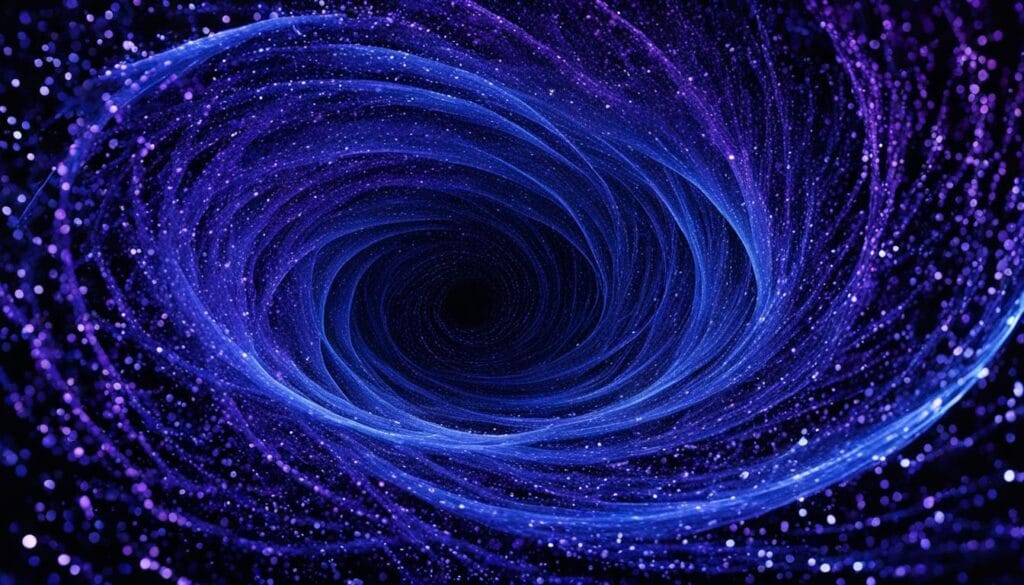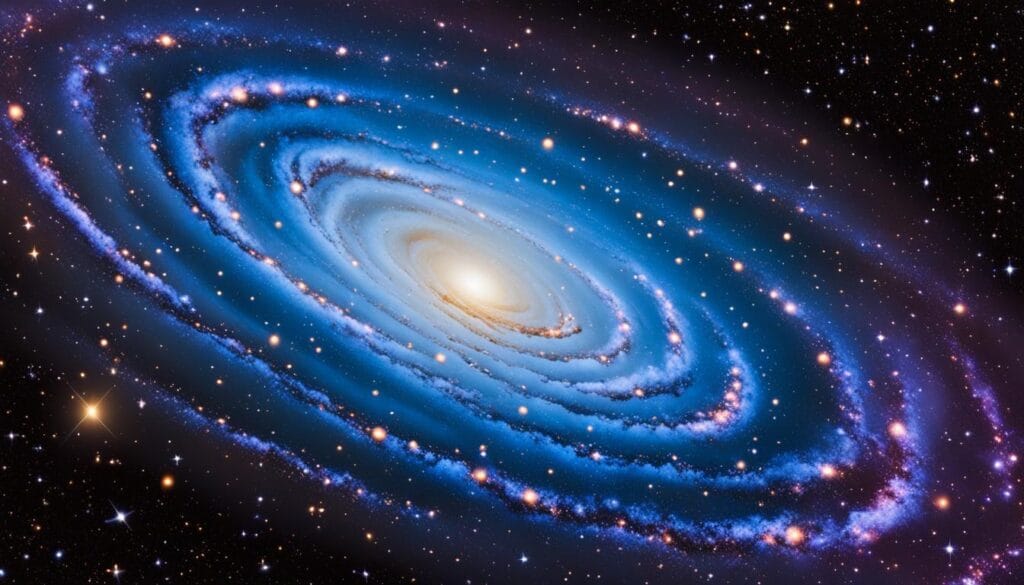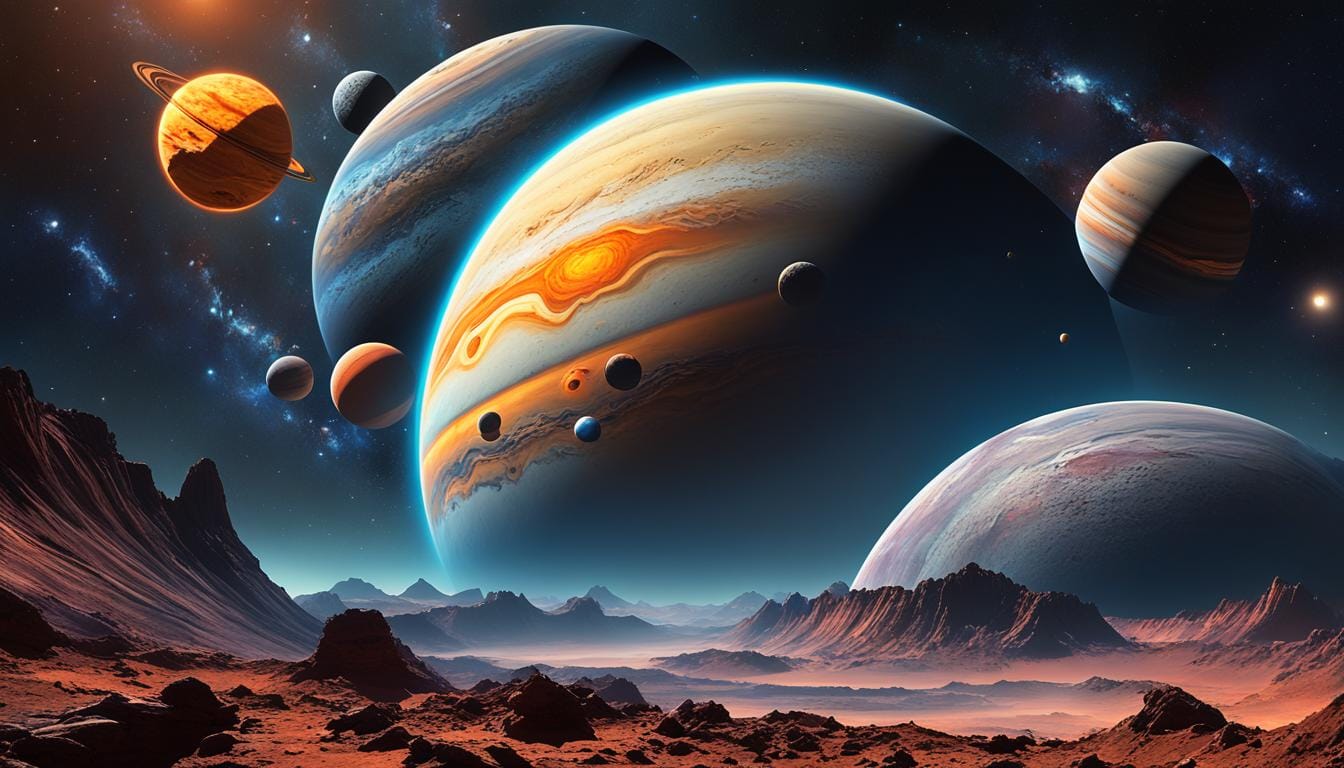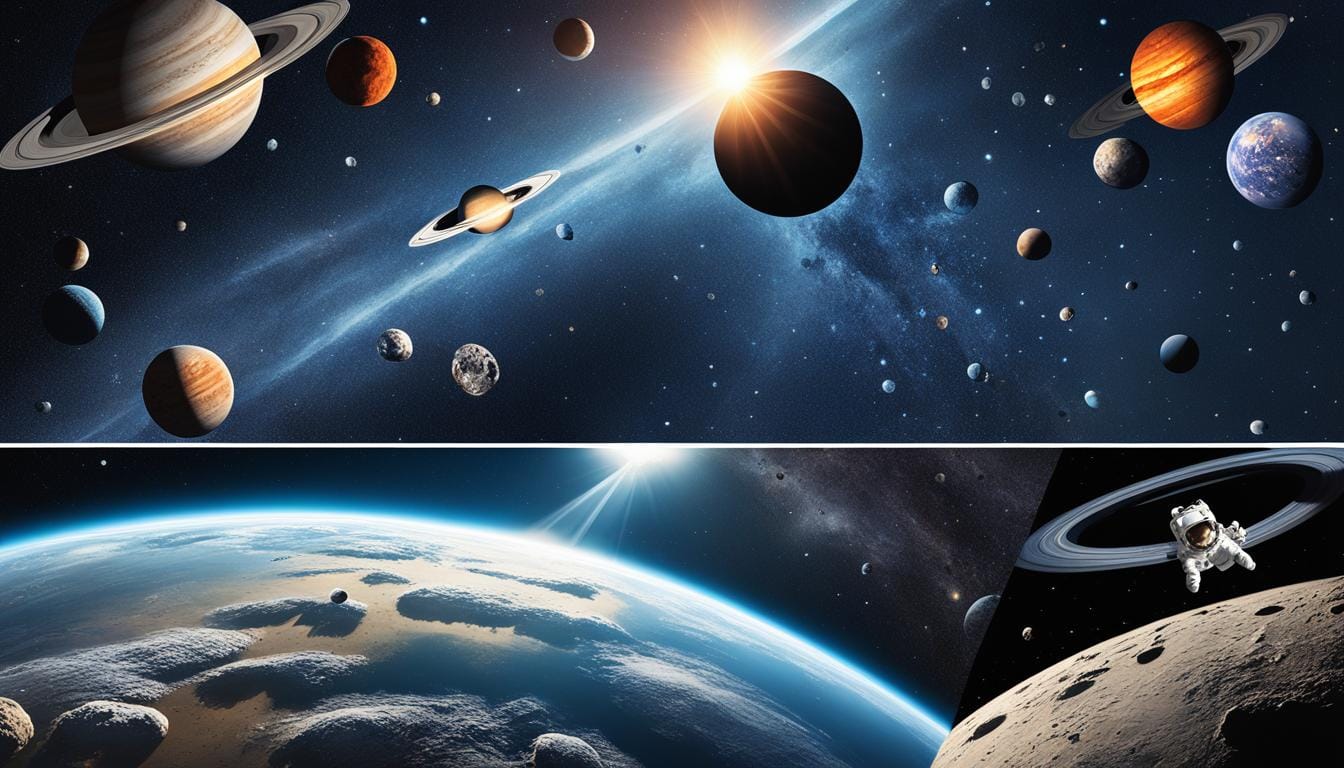Do you Know? Dark matter is a big mystery in our universe. It makes up over three-quarters of the universe’s mass but is invisible. Scientists are working hard to learn about this hidden part of the cosmos.
They found that the universe has a lot of unseen mass because of gravitational anomalies and strange galaxy movements. This unseen mass, called dark matter, helps shape the universe’s structure. It forms a web that guides galaxies and affects how stars and planets move.
Finding out about dark matter is a big challenge for scientists. The Standard Model explains some of the universe, but not all. Dark matter and dark energy make up 95% of the universe, but we don’t know much about them. This mystery has caught the interest of scientists all over the world.
This article will look into the proof that dark matter exists. We’ll talk about the search for it and what it means for our universe. We’ll explore how dark matter affects the visible universe, including gravitational lensing and galaxy movements. This will help us understand one of the biggest mysteries in science.
What is Dark Matter?
A mysterious substance that makes up a big part of the universe is Dark matter. It has been a puzzle for scientists for many years. Even though it makes up over 80% of the universe’s mass, it doesn’t show up on our telescopes. We know it exists because of how it affects visible matter and the universe’s structure.
The Invisible Mass of the Universe
Scientists have found that the universe is mostly invisible. The stars, galaxies, and gas we see are just a small part of it. Dark matter is thought to be about 27% of the universe, and dark energy around 68%. Dark matter’s gravity helps shape galaxies and clusters.
Baryonic matter, which includes planets, stars, and us, is less than 5% of the universe’s mass. The rest is dark matter and dark energy, which we can’t see or measure directly.

In the 1990s, scientists found dark energy, which surprised them. It makes the universe expand faster than expected. This discovery has helped us understand the universe better and the role of dark matter.
Dark Matter Mysteries
The dark matter enigmas are a big puzzle for scientists. They are among the biggest cosmic mysteries and astrophysical conundrums today. Even though we know it exists, we don’t know what it is. Many theories, like WIMPs and axions, have been suggested, but none have been found yet.
Scientists are working hard to find dark matter. They use advanced methods to search for it, pushing the limits of science. For years, they’ve known that most of the universe’s mass is not visible. This has made finding dark matter a major challenge.
A recent study in Physical Review Letters talked about a new idea for dark matter. It mentioned primordial black holes as a possible dark matter type. These black holes could have formed right after the Big Bang. They might have changed the early universe’s balance of protons and neutrons.
Researchers are still searching for dark matter, hoping to solve these cosmic mysteries and astrophysical conundrums. Finding out what dark matter is could change how we see the universe and its history.

The Evidence for Dark Matter
Invisible form of matter that makes up most of the universe. Astronomers like Vera Rubin and Fritz Zwicky have found strong proof of its existence. Their work has shown us that there’s a lot of mass out there we can’t see.
Gravitational Anomalies and Galaxy Dynamics
In the late 1970s, Vera Rubin found something surprising. The stars on the edges of spiral galaxies were moving faster than they should have been. This meant there was unseen mass pulling them together. Rubin’s work, along with Zwicky’s on galaxy clusters, showed us that dark matter was real.
Gravitational lensing, which bends light around massive objects, also points to dark matter. The cosmic microwave background and the universe’s structure tell us there’s a lot of mass we can’t see.
| Metric | Value |
|---|---|
| Dark matter accounts for about 85 percent of all matter in the universe | 85% |
| Dark matter is about five times more common than normal matter | 5 times |
| Hidden-sector particles proposed as dark matter candidates have lower mass and energy compared to other candidates | Milli- to giga-electron-volts (eV) |
Scientists are now working hard to understand dark matter better. They’re looking for dark matter candidates to help us grasp this mysterious part of our universe.
Dark Matter and the Formation of Cosmic Structures
Dark matter is key to the universe’s large-scale structure and evolution. Simulations and observations show it acts as a gravitational framework. This framework guides visible matter into galaxies, clusters, and filaments. Dark matter’s clumping led to the early formation of stars and galaxies, shaping our universe.
The universe’s structure forms in three main phases. Before the cosmic microwave background, dark matter helped density fluctuations grow. Ordinary matter was stuck with photons, unable to collapse.
With the cosmic microwave background’s release, the universe expanded and cooled. Dark matter, not interacting with photons, grew denser, seeding future structures. Ordinary matter then decoupled from photons, condensing under dark matter’s gravity.
The first stars and galaxies changed the universe further. Their energy and radiation affected the gas and dark matter. This process, called reionization, changed the cosmic microwave background, leaving a mark on its patterns.
Today, dark matter makes up about 85% of the universe, with ordinary matter at 15%. Dark matter’s distribution, seen through gravitational lensing and simulations, helps us understand the universe’s structure and evolution.
| Key Phases of Cosmic Structure Formation | Description |
|---|---|
| Before the Cosmic Microwave Background | Dark matter grows density fluctuations, while ordinary matter is stuck with photons, unable to collapse. |
| Between the Cosmic Microwave Background and First Stars/Galaxies | Dark matter grows denser, creating seeds for future structures. Ordinary matter starts to condense under dark matter’s gravity. |
| After the Formation of First Stars/Galaxies | The first stars and galaxies shape the universe further. Their energy and radiation trigger reionization, affecting the gas and dark matter. |
The interaction between dark matter and cosmic structures is crucial to understanding the universe. As we learn more about dark matter, we’ll gain deeper insights into the universe’s origins and evolution.
Searching for Dark Matter Candidates
Scientists are on a quest to find out what dark matter is. They have many theories, each with its own set of features and hurdles. WIMPs, or weakly interacting massive particles, are top contenders. They fit into some models of particle physics.
The axion is another strong candidate. It’s a tiny particle created to fix a problem in quantum chromodynamics. Some scientists also think that changing gravity’s laws could explain dark matter’s effects.
- Approximately 80% of the matter in the universe is dark matter.
- Dark matter is passing through us possibly at a rate of trillions of particles per second.
- The research team aims to detect dark matter candidates with masses between 0.01 to a few hydrogen atoms.
- The dark matter particles being searched for could weigh between five and 1,000 times more than a hydrogen atom.
- Axions, if they make up dark matter, would be more than a billion times lighter than a hydrogen atom.
| Candidate | Characteristics | Challenges |
|---|---|---|
| WIMPs (Weakly Interacting Massive Particles) | Predicted by extensions of the Standard Model of particle physics | The exclusion limits of the spin-independent cross-section of WIMP-nucleon are around 10^{-7}pb at the high mass region and 10^{-5}pb at the low mass region. |
| Axions | Ultra-lightweight particles hypothesized to solve a problem in quantum chromodynamics | Axions, if they make up dark matter, would be more than a billion times lighter than a hydrogen atom. |
| Modified Gravity | Modifications to the laws of gravity as an explanation for the observed gravitational effects attributed to dark matter | Challenges in developing a comprehensive and robust theory of modified gravity that can accurately describe the observed cosmological and astrophysical phenomena. |
Scientists are hard at work to find dark matter. They use advanced tech and experiments to detect these mysterious particles. This includes using quantum tech at super-low temps to make detectors.
The Cosmic Web of Dark Matter
The universe is much more complex than it seems. Underneath the stars and galaxies, there’s a hidden web of dark matter. This dark matter cosmic web is key to the universe’s structure. It helps shape where stars and galaxies live.
Scientists use gravitational lensing to see the dark matter in space. The Dark Energy Survey shows us the hidden parts of the universe. It’s like uncovering a world full of secrets.
Mapping the Invisible Universe
Distant galaxies show us the paths of dark matter. These paths form the large-scale structure of the universe. By using computers and observations, scientists are learning more about dark matter.
The Dark Energy Survey is helping us understand the invisible universe better. By solving the mysteries of the cosmic web, we might learn about dark matter. This could help us understand how the universe came to be.
Dark Matter and the Future of Cosmology
The mysteries of dark matter deeply affect our grasp of the universe and the future of astrophysics. Finding out what dark matter is could lead to big changes in particle physics. It might show us new particles or make us rethink gravity. Plus, understanding dark matter’s role in the universe could tell us about the universe’s early days and how galaxies and stars formed.
Scientists are working hard to explore dark matter. Projects like the Rubin Observatory’s Legacy Survey of Space and Time (LSST) will give us a lot of data on dark matter. This could lead to new insights and discoveries that change how we see the cosmos.
Looking into dark matter is both a scientific and philosophical journey. It makes us question our view of the universe. As we learn more, we might find new particles and forces. This could also change how we think about reality. The future of cosmology might bring groundbreaking revelations that change our understanding of the universe and our place in it.
The Dark Energy Survey
The Dark Energy Survey (DES) is a big project to learn about dark matter and dark energy. These are the main parts of the universe we can’t see. It uses the Victor M. Blanco Telescope in Chile. This survey has taken pictures of hundreds of millions of galaxies, giving us new insights into the universe’s structure.
Researchers use the shapes and positions of these galaxies to find dark matter. This method, called gravitational lensing, helps the DES team map dark matter in the universe. This mapping shows us the cosmic web that shapes the universe’s structure.
Over 400 experts from more than 25 countries work on the DES. They aim to understand dark energy, which makes the universe expand faster. By studying over 1,500 supernovae, they’ve learned a lot about dark energy.
Their findings suggest dark energy might not be as simple as thought. This could change how we see the universe and its forces.
Unveiling the Cosmic Landscape
The DES uses advanced technology and teamwork to explore the universe. It’s mapping dark matter and studying dark energy. This project could change how we understand the universe.
| Key Findings | Data Points |
|---|---|
| Dark Energy Survey Supernova Analysis |
|
| Dark Matter Mapping |
|
| International Collaboration |
|
Challenges in Detecting Dark Matter
Finding dark matter is a big challenge in today’s science. Its weak gravity signals need special tools, advanced data handling, and complex models to understand. Techniques like gravitational lensing help us see its effects.
Errors from the atmosphere, instrument flaws, and galaxy complexity add to the challenge. For example, most of the Milky Way’s mass is dark matter, which is nine times more than what we can see.
Beating these tech and analysis challenges is key to uncovering dark matter secrets. Studies show black holes make up a tiny part of dark matter. This means we need other theories for the big black holes found by LIGO and Virgo.
| Statistic | Value |
|---|---|
| Percentage of dark matter in the Milky Way Galaxy | 90% |
| Ratio of dark matter to visible matter in the Milky Way Galaxy | 9:1 |
| Percentage of dark matter that can be attributed to black holes of various masses | 1.2% (10 solar masses), 3.0% (100 solar masses), 11% (1,000 solar masses) |
| Number of microlensing events detected by OGLE astronomers | 13 |
The quest to find dark matter is tough because of the need for data processing and complex models. These efforts are crucial for understanding the unseen universe and dark matter.
The Interplay of Dark Matter and Dark Energy
Dark energy makes up over 95% of our universe. Dark matter helps form stars and galaxies. Dark energy makes the universe expand faster. These forces work together to shape our universe’s future.
Dark matter is invisible but affects galaxies and matter. It helps create galaxies and galaxy clusters. But, dark energy pushes the universe apart, fighting against dark matter’s pull.
Understanding dark matter and energy is key to knowing our universe’s history and future. Scientists use advanced tools like the Large Hadron Collider and the Dark Energy Survey. These tools help us learn how these forces interact.
We’ll understand the universe better as we learn more about dark matter and dark energy. This knowledge will help us see how the universe will change. It’s like solving a cosmic puzzle.
The Future of Dark Matter Research
The search for dark matter is pushing the limits of new detection methods and theories. Scientists are using everything from experiments to computer simulations to find this mysterious stuff. They’re looking for particles like WIMPs and axions, and studying the universe in new ways.
New Experiments and Theoretical Developments
New tools and better theories are opening up new possibilities in dark matter research. The Deep Underground Neutrino Experiment (DUNE) is a big project with over 1,400 experts from 36 countries. It’s set to start in 2028 and could reveal secrets about dark matter and the universe.
At the SLAC National Accelerator Laboratory, scientists have a new idea for finding dark matter. They want to use quantum devices to spot “thermalized” dark matter around Earth. This could be a game-changer in understanding dark matter and where it lives in the universe.
The search for dark matter is getting more exciting every day. With new tools and ideas, scientists are closer than ever to solving the mystery of dark matter. This could change how we see the universe and its secrets.
The Impact of Dark Matter on Our Understanding of the Universe
Studying dark matter changes how we see the universe and its laws. Finding out what it is could lead to new discoveries or changes in gravity theories. This could start a big change in how we understand particles and the universe.
Dark matter makes up about 27% of the universe, and dark energy about 68%. These mysterious parts greatly affect the universe. In the 1930s, Fritz Zwicky first thought of dark matter after looking at the Coma cluster. But, we still don’t know much about it, even after many experiments.
Looking into dark matter and dark energy could tell us about the universe’s early days and how galaxies and stars formed. This search is not just about science. It’s about understanding the universe’s very nature.
| Component | Percentage of the Universe |
|---|---|
| Dark Matter | 27% |
| Dark Energy | 68% |
| Regular Matter | 4% |
Dark matter and dark energy challenge our basic physics knowledge. They suggest there are new laws of nature we haven’t found yet. As we learn more, we get closer to understanding the universe and where it came from.
Conclusion
Dark matter is a big mystery in science today. It’s hard to understand and challenges our tech and analysis. Despite strong proof that it exists, we still don’t know what it is. This mystery has pushed science forward, especially in fields like particle physics and astrophysics.
Researchers are working hard to find new ways to detect dark matter and improve theories. This could lead to big discoveries that change how we see the universe and its laws. Since we know only 15% of the universe’s matter, the rest is still a big puzzle for scientists.
At the American Physical Society’s meeting in April, scientists talked about dark matter and how to find it. They think ultra-faint compact stellar systems could help us understand dark matter better. If they prove dark matter is in these systems, it could help us learn more about the universe’s creation and evolution.


